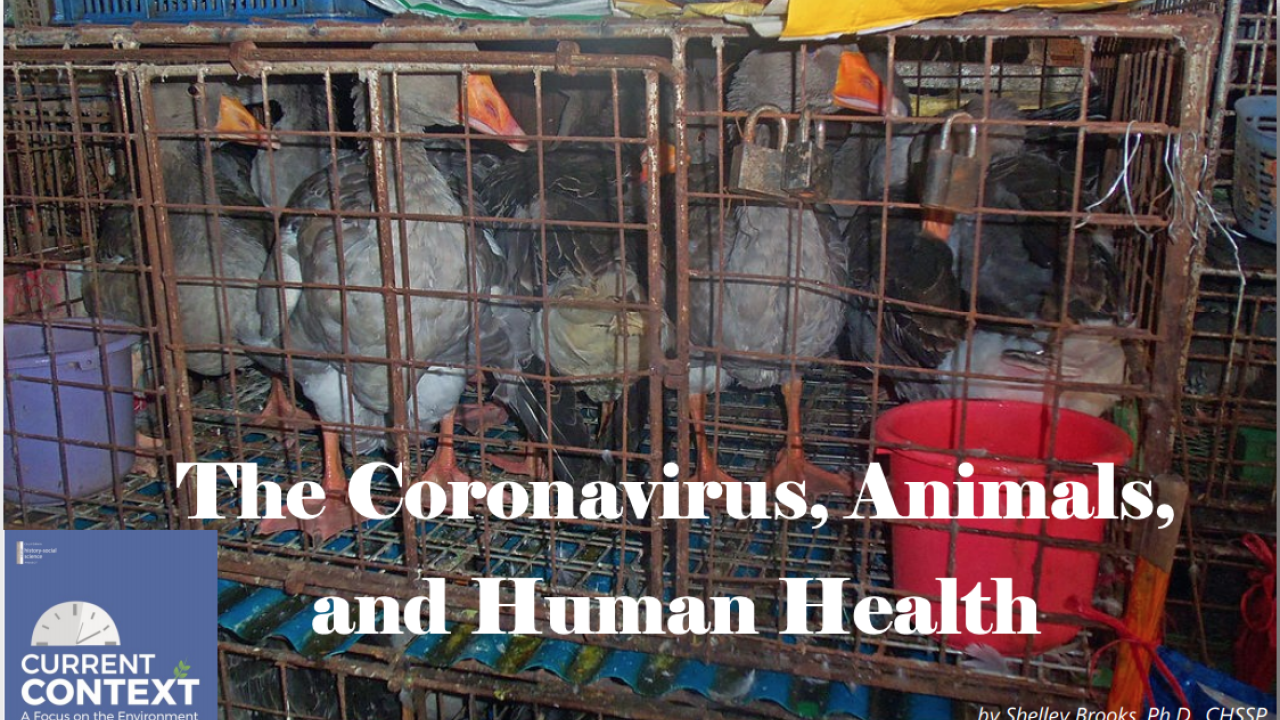
The Coronavirus, Animals, and Human Health
Abstract: The coronavirus, known as the COVID-19 disease, began in China at the end of last year and is now a worldwide health concern. The term “coronavirus” is broad and encompasses viruses such as the common cold. COVID-19 did not exist in humans prior to its recent outbreak. To date, nearly one hundred thousand have become sick and over three thousand have died. By far the majority of cases are in China, but the spread of the disease is slowing there after strict quarantine measures have helped check the spread of this infectious disease. Meanwhile, new clusters of the disease are emerging in countries around the world. The World Health Organization (WHO) is urging people who are sick to stay at home and not infect others in their community. The WHO is also reminding everyone to practice good hygiene – washing hands frequently, and covering coughs and sneezes that can transport the virus to people within about six feet. It is also possible that a person can catch the virus by touching a surface (such as a door handle) recently touched by an infected person, and then touching eyes, nose or mouth. Scientists and health care professionals are studying the new virus and disease to learn more and to try to slow its transmission. The WHO recently declared COVID-19 to be a very high health risk for the global community.
Teaching suggestions
On March 5 the CHSSP published a Current Context on the coronavirus, the virus that causes the COVID-19 disease. The realities of early March now seem quite distant. Recent school and work closures, community shelter-in-place directives and other drastic measures are all responses to the World Health Organization’s declaration on March 11 that COVID-19 is indeed a pandemic, a new disease that spreads worldwide. Though this particular disease is new, the conditions that created it are ancient. Moreover, pandemics have occurred throughout history. The current context issue on the coronavirus provides historical background and examples for understanding how and why people and animals share diseases, how these diseases spread, and how economic, political, environmental and social factors influence the impact of a given disease.
Below is a list of inquiry questions that connect grade-level content to today’s COVID-19 pandemic. Included beneath the grade level questions are links to history-social science resources on such topics as disease and public health, trade, agriculture, and biodiversity. A majority of the lessons come from the State Board of Education-approved Education and the Environment Initiative (EEI).
12th Grade (Gov) – How is the government responsible for slowing the spread of COVID-19? What specific government measures are appropriate to support human health and community wellbeing? What rights and responsibilities do citizens have during a pandemic, and how might these be different than during ordinary times?
- Suggested resource on government regulation of public and environmental health: EEI unit 12.7.6 Making and Implementing Environmental Laws
12th Grade (Econ) – What specific forms of government intervention in the economy are appropriate during a pandemic? What are the cascading economic effects of a pandemic?
- Suggested resource on government regulations that have economic implications: EEI unit 12.2.2/7 Sustaining Economies and the Earth’s Resources
10th and 11th Grade History – How are today's global interconnections a factor in the spread of COVID-19? How do today’s global interconnections offer opportunities for combatting the spread of the disease? How does this pandemic impact political, economic, and social connections among the nations of the world? What role do governments play in promoting public health during times of crisis?
- Suggested resources on industrialization and population growth & debates surrounding appropriate environmental policy to address global concerns: EEI unit 10.3.3 Growth of Population, Cities, and Demands & 11.11.5 Many Voices, Many Visions: Analyzing Contemporary Environmental Issues
8th Grade History – How did scientists and physicians understand germs and the spread of disease during the eighteenth and nineteenth centuries? How does that compare to how we understand them today? How is sanitation (clean water and safe waste disposal) important to limiting the spread of disease?
- Suggested resource on the relationship between industrial developments and human health: EEI unit 8.12.1 Agricultural and Industrial Development in the United States (1877-1914)
7th Grade History – What are the social and economic benefits of contact between cultures? What are the risks associated with such contact?
- Suggested resources on trade, disease, and cultural contact during the middle ages: a CHSSP resource on the Black Death in the medieval world & EEI unit 7.2.5 Arabic Trade Networks: Growth and Expansions in the Middle Ages & 7.6.3 Managing Nature’s Bounty: Feudalism in Medieval Europe & 7.7.1 Sun Gods and Jaguar Kings & 7.7.3 Broken Jade and Tarnished Gold
Studying history teaches us about the ways societies in the past have experienced highs and lows, and how these societies have responded creatively and productively with inventions, medicines, vaccines and other measures to improve human lives. As we study the past, we can also help create the sources and evidence that future historians will need in order to understand and write about the world as it existed in 2020. The UC Berkeley History-Social Science Project recently shared this excellent resource that outlines a journaling activity on today’s pandemic. This is an unusual time, but not without precedent in history. It may help to focus on the fact that before long this pandemic will also be a thing of the past.
Please be in touch if you have questions or information to share! You can reach us at chssp@ucdavis.edu.
